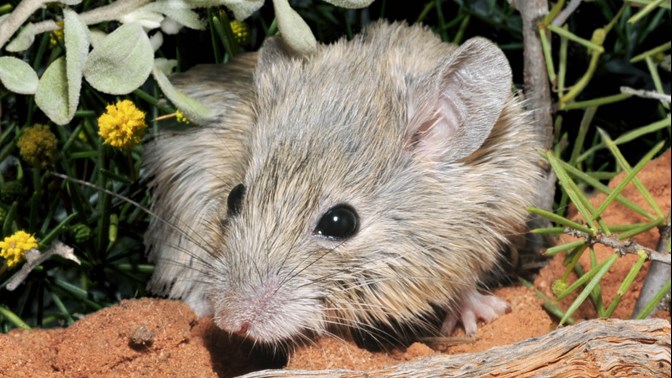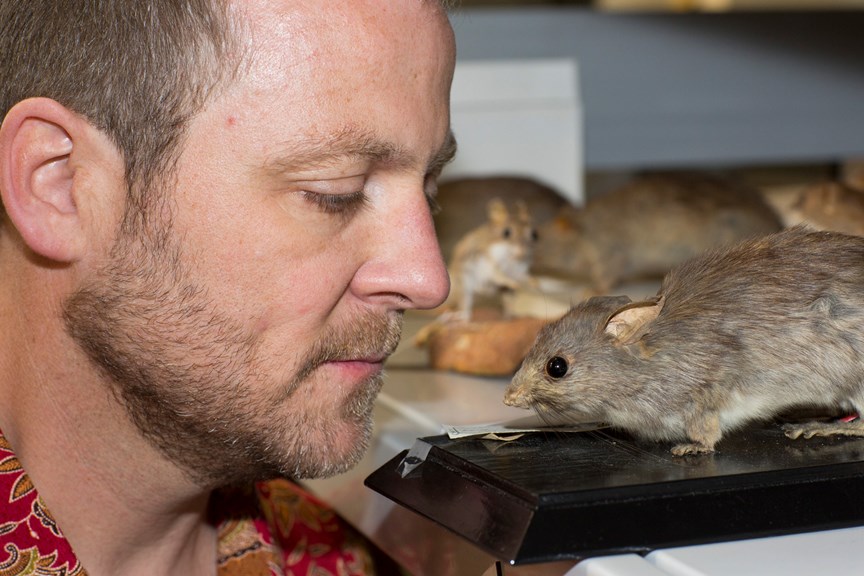Hiding in plain sight: Museum specimens resurrect native Australian mouse from extinction
Museum genomics reveal a mouse thought to have been extinct for over 160 years has been living under a different name this whole time, and study reveals the catastrophic impact of European settlement on native Australian rodent species.
Research published today in internationally renowned science journal PNAS has taxonomically resurrected an Australian rodent species formerly thought to be extinct, Gould’s mouse (Pseudomys gouldii) which disappeared from Victoria and NSW over 160 years ago.
Genomic data from eight extinct Australian rodent species were studied using museum specimens up to 174 years old, along with 42 of their living relatives, to examine the decline of endemic species since European arrival.
Gould’s mouse was found to be genetically indistinguishable from another native mouse that survived on a single island in Shark Bay, WA, where it was known as Djoongari to First Peoples and known to science as Pseudomys fieldi. Prior to this, Gould’s mouse was first collected in 1837 from the Hunter River Valley of New South Wales by Charles Darwin’s expedition and last documented by the William Blandowski’s expedition to the Murray River, on the Victoria-New South Wales border. Specimens from both these expeditions were preserved for over 160 years by the Natural History Museum London and Museums Victoria and sequenced in this study.
‘It’s very exciting, I think everybody likes the idea of removing a species from the ever-growing list of extinct species in Australia,’ says the study’s lead author, Dr Emily Roycroft.
For simplicity the species will still be known as the Djoongari or Shark Bay Mouse, while reverting to the original scientific name Pseudomys gouldii.
‘We pay our respect to the Malgana people of Shark Bay, known to them as Gutharraguda, on whose lands this species survived. Once a continental Australian species widespread from WA to NSW, the Djoongari, Pseudomys gouldii now survives only on the lands of the Malgana,’ says Dr Kevin Rowe, senior curator of mammals at Museums Victoria.
The resurrection of this species brings good news in the face of the disproportionally high rate of native rodent extinction, making up 41% of Australian mammal extinction since European arrival in 1788 despite making up only 19% of terrestrial mammal species diversity.
In addition to Gould’s Mouse, the study examined seven other extinct native species: the White-footed Rabbit Rat, Lesser Stick-nest Rat, Bramble Cay Melomys, Short-tailed Hopping Mouse, Long-tailed Hopping Mouse, Big-eared Hopping Mouse, and Long-eared Mouse.
‘These species weren't already in decline; they died out because humans introduced something dramatic to alter their fate and the landscape,’ says Rowe, as data from the study shows relatively high genetic diversity immediately before extinction, suggesting these species had large, widespread populations.
Dr Roycroft says the findings demonstrate that genetic diversity does not provide guaranteed insurance against extinction.
‘The introduction of feral cats, foxes, and other invasive species, agricultural land clearing and new diseases… absolutely decimated native species that were otherwise relatively stable and potentially had quite large population sizes,’ she says.
This genomics resource was generated as part of the Oz Mammals Genomics initiative supported by Bioplatforms Australia through the Australian Government National Collaborative Research Infrastructure Strategy.
‘This study highlights the important role of museum collections in the conservation and management of native species. The Darwin and Blandowski expeditions had no idea that the skins they collected housed DNA, nor that two centuries later, those dried skins preserved in Museums Victoria and the Natural History Museum London would reveal their genetic link to a living species on the other side of the continent. It's a reminder of the value of museum specimens over centuries including those to come.
‘Darwin and Blandowski left us a couple of dried skins, but scientists two centuries from now will have access to much better-preserved DNA, such as tissues stored in liquid nitrogen. Or even the living cells of threatened species, a new initiative of Museums Victoria and the Ian Potter Wildlife Biobank,’ says Dr Rowe.
Treasures of the Natural World, produced and curated by the Natural History Museum, London, is now opening at Melbourne Museum.
Museums Victoria aims to inform understanding of our changing environment and contribute to the long-term protection and recovery of Australia’s endangered species and native fauna.
Support our world-leading experts to continue vital research, conservation, and education programs to advance biodiversity and ensure a thriving future.









